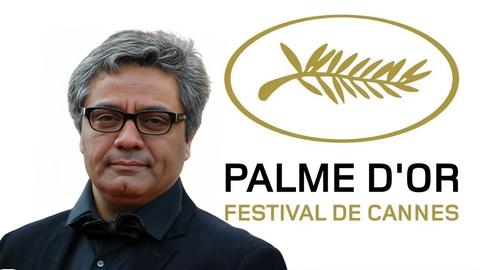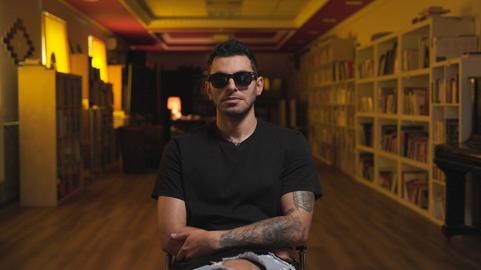Multi-disciplinary artist Hamid Rahmanian has his wife Melissa Hibbard to thank for kickstarting the enterprise that has occupied his every waking moment for the last 15 years. It was in 2008, after he complained about an unedifying orchestral concert they had attended in Toronto, that Melissa threw down a challenge. “You Iranians always talk about how glorious your past was, what amazing culture you created,” she told him. “But you guys are just sitting in your own corner, talking about the past. There have been 40 years of immigration after the revolution but no one here knows about your glorious culture. Why don’t you stop complaining and do something about that?”
Hamid rose to the bait. “I’ll show you,” he thought. But the question was what could he do to bring his heritage, about which he felt so passionately, to Western audiences? “I had physically migrated but, mentally, somehow, I felt committed to promote my culture one way or another. I thought there must be a place for me to talk about our visual traditions and literature. It is something that defines Iran, because the country itself has constantly been invaded by different forces and there are a lot of political problems all the time. But what unites us and what’s makes Iran stand out is our poetry and visual traditions. And it’s not being introduced properly to Western audiences.” Hamid alighted upon the epic masterpiece Shahnameh, versified by Ferdowsi a thousand years ago, that charts the heroic, mythological, and to some degree historical, past of the Persian Empire. But Shahnameh was not a book Hamid had always warmed to. As a boy, when his father had urged him to read it, he had found it intimidating. “I was scared of it because it’s huge. It has a lot of plots, a lot of complicated names, and you feel that you have to have a special kind of knowledge of literature to understand it.” But at the same time, he knew that the Shahnameh was the identity of Iranian culture. And all the better that it contains the roots of such well-known stories as King Lear, Romeo and Juliet, Rapunzel, even The Jungle Book; so why couldn’t it be appealing to Western audiences?
Shahnameh holds a unique position in Iranian hearts and minds and, Hamid believes, almost single-handedly kept the Persian language alive. “Unlike all the ex-territories of the Roman Empire that lost their language to Arabic – Libya, Egypt, Syria, Lebanon – Iran kept its language because of this book. And also, this is the book that somehow connects Iranians right now to pre-Islamic Iran.” It is a text that is still part of the conversation in Iran today. A comparison might be the Iliad and the Odyssey of Homer, which are very familiar in the West. “If something happens today in Greece, no one will be talking about Greek mythology – they don’t relate to that,” he says. “But, in Iran, every uprising, every resistance, every slogan, whenever people take any action, it’s somehow referred back to Shahnameh.”
As a trained graphic designer and animator, Hamid believed the Shahnameh would lend itself well to a visual treatment because, for the last 600 years, there has been a common visual language in the Middle East. “I thought that would be my mission – to create a new, fully illustrated edition of the Shahnameh based on the rich visual history of the region spanning from Moghul India to the Ottoman Empire. Hamid researched more than 8,000 miniatures and lithographs from the late 14th century to mid-19th century to come up with the visual approach to the illustrations.
The first step for Hamid and Melissa, who have collaborated on all these projects, was to commission a new translation from Dr. Ahmad Sadri, that was coherent, contemporary and focussed on the characters. They approached it as they would a movie script, targeted at an audience that loves Lord of the Rings, Star Wars and Game of Thrones. After 10,000 hours of work, the book was published in 2013 to wide acclaim. It is now in its ninth edition. Energised by the reception to the book, they began to consider other projects drawing upon the stories in Shahnameh. They turned their attention to producing pop-up books, of which Hamid has a large collection. Hamid collaborated with paper engineer Simon Arizpe to design the first popup book, Zahhak: The Legend of the Serpent Kings, which was awarded the 2018 Meggendorfer Award, “It’s like the Oscars for pop-up books,” Hamid says. Riding on its success, they created another exquisite volume, The Seven Trials of Rostam.
But there are always more stories to tell from Shahnameh and more ways to tell them. The initial challenge made by Melissa has now reached hundreds of thousands of appreciative people through other media and platforms. For example, an 80-minute puppet show, Song of the North, features 483 puppets, nine actors and 208 animated backgrounds. “There is nothing like it,” says Hamid. “I literally sat down and dedicated three years of my life to it. Whatever I had in my heart and my talent and my mind, I poured into this production. It’s an almost cinematic experience. For the audience, it’s like watching a movie while backstage we are actually making that movie in real time.” Another hugely elaborate shadow theatre piece, Feathers of Fire, won the 2019 UNIMA award for excellence in live performance and design and found a high-profile fan in the legendary film director Francis Ford Coppola, who praised its “spectacular cinematic wizardry.” Coppola then provided the introduction to an audiobook of Shahnameh in which the stories are brilliantly told by award-winning voice actor Marc Thompson, accompanied by 12 hours of evocative sound design and music Then, an animated film and dynamic lighting design by Hamid formed the backdrop to concerts by cellist Yo-Yo Ma’s Silk Road Ensemble, in collaboration with virtuoso Kayhan Kalhor. Unfortunately, the performances were halted by the COVID-19 pandemic. “I’m thinking about actually reviving that and expanding it into a much bigger concert,” says Hamid.
Through such productions, stories from the Shahnameh have now touched the lives of people of all ages and backgrounds. “We perform sometimes in lower income neighbourhoods,” Hamid explains. “The last show we performed reached 43,000 kids in red Republican [US] states. People who watch Fox News and things like that come and see these amazing productions and learn about the beauty of the Persian culture. My last show was the most watched puppet show in America after The Lion King. We performed 112 times to more than 120,000 people.” And it’s not just families that have been captivated by this 21st century approach to bringing the Shanameh to life; Hamid’s books have been spotted on the coffee tables of high profile individuals including, amongst others, Barack Obama, Hilary Clinton and Narendra Modi, the Prime Minister of India.
Hamid’s devotion to bringing Shahnameh to the masses has taken on epic proportions, worthy of the poem itself and has overtaken his life. “Sometimes I’m a film director. Sometimes I’m a theatre director. Sometimes I’m a puppet designer. Sometimes I’m a bookmaker. Sometimes I’m an illustrator,” he jokes. “Six or seven months ago I was a book publisher. At this point right now I’m a book distributor.” There are further plans afoot, which he will be announcing soon.
“I feel this is my responsibility,” says Hamid, “to produce this body of work to bring something new from this underdog culture to Americans or Westerners because, whatever you hear about us, it goes through the prism of politics. A lot of love, passion and responsibility goes into creating this body of work, because you’re dealing with a national identity, a culture that has been demonized for such a long time. So everything is done with the utmost diligence, attention and respect to create something worthy of the original text that had kept the Persian language alive, kept the tradition alive, and still is fuel for the people on the street to create slogans against the tyranny of the regime.”
“I feel that Iran is like a symphony, but you only hear a few notes,” he muses. “From this symphony, you’re actually missing a lot of dynamics, harmonies and nuances. As an ancient culture, it’s still alive and needs to be recognized for its contributions. And more importantly, as our immigrant community settles here after 40 years, we should be encouraged to create culture so that we can become part of the rich tapestry of this new home. For me Shanameh is how I’m contributing to this cultural fabric.”
Hamid continues on his path. This fall, he will be re-releasing his award-winning pop-up book Zahhak: The Legend of the Serpent Kings. It’s currently available for pre-sale.
All of Hamid Rahmanian’s work can be seen at www.kingorama.com.
visit the accountability section
In this section of Iran Wire, you can contact the officials and launch your campaign for various problems





























comments